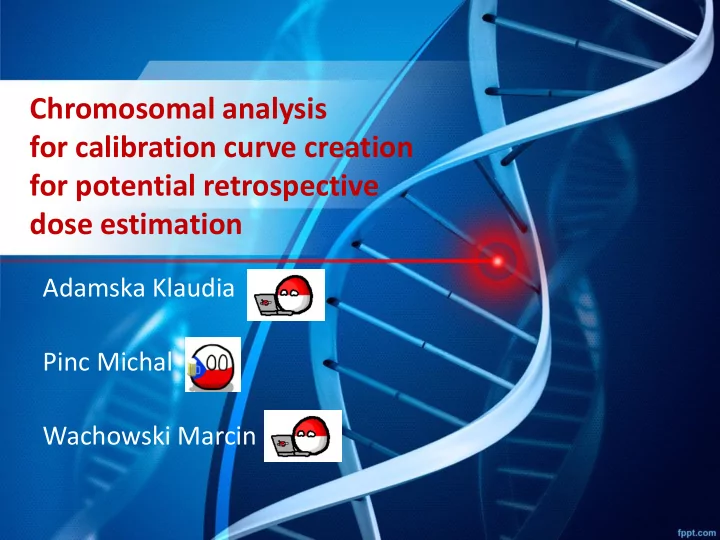

Chromosomal analysis for calibration curve creation for potential retrospective dose estimation Adamska Klaudia Pinc Michal Wachowski Marcin
Project supervision • The research was performed in the Laboratory of Radiobiology, JINR, under the supervision of Dr Polina Kutsalo
Table of content: • Aim of the project • Background info • The experiment • Results • Conclusion
The aim of the project: • Estimation of absorbed dose, based on chromosome observation • Creation of a curve basing on radiation- induced unstable chromosomal aberrations
Background info: Chromosome
Background info: Chromosome aberrations Chromatid Chromosome Acentric Centric ring Normal Translocation with fragment break fragment ring Reciprocal exchange Chromatid exchange Dicentric with fragment
Microscopic image of metaphase chromosomes with visible dicentric
The experiment: PHA Culture of Irradiated BrdU Colcemid blood Fixation 0-24 h 46h 48-50h Image visible under light microscope
The experiment – lymphocytes isolation Peripheral Blood Mononuclear Cell
Results (our team’s results)
Results (control – dr. Kutsalo’s results)
Conclusion • The amount and severity of aberration is certainly dose-dependant • It is possible to estimate the dose retrospectively, using the curve created at the basis of samples irradiated with known dose and radiation type
Acknowledgements: • Chen et al., 2011. Biological dose estimation for accidental supra-high dose gamma-ray exposure. Radiation Measurements 46, 837-841. • Gotoh, 2005. Simple biodosimetry method for use in cases of high-dose radiation exposure that scores the chromosome number of Giemsa-stained drug-induced prematurely condensed chromosomes (PCC). Int. J. Radiat. Biol., vol 81. • IAEA, 2011. Cytogenic dosimetry: Applications in Prepardness for and Response to Radiation Emergencies. • Khvostunov et al., 2011. Recent experience in applying the cytogenetic dosimetry assay. Radiation Measurements 46, 832-836. • Nettelbeck and Rabus, 2011. Nanodosimetry: The missing link between radiobiology and radiation physics? Radiation Measurements 46, 893-897.
Thank You for Your attention
Recommend
More recommend